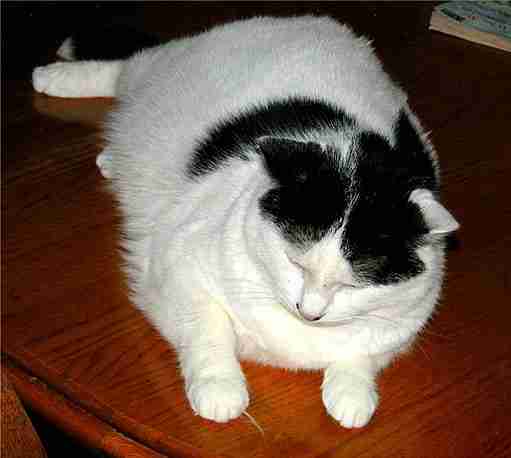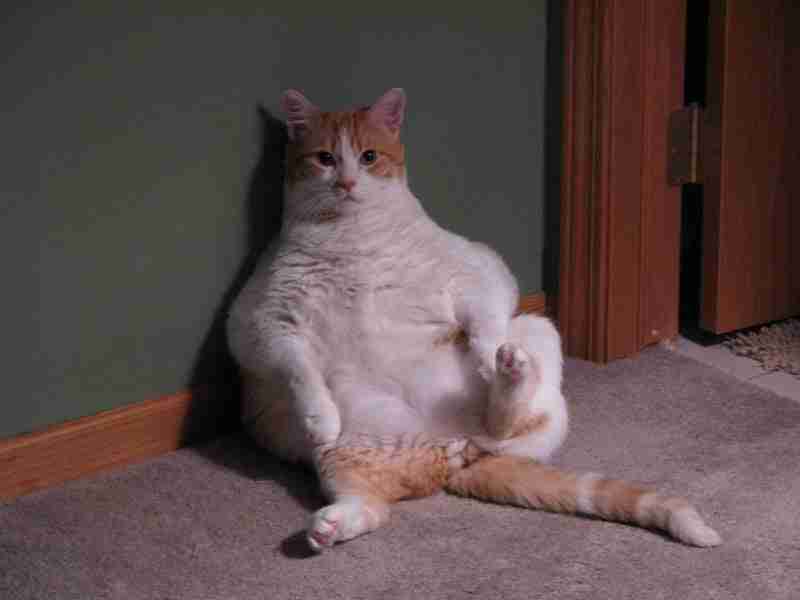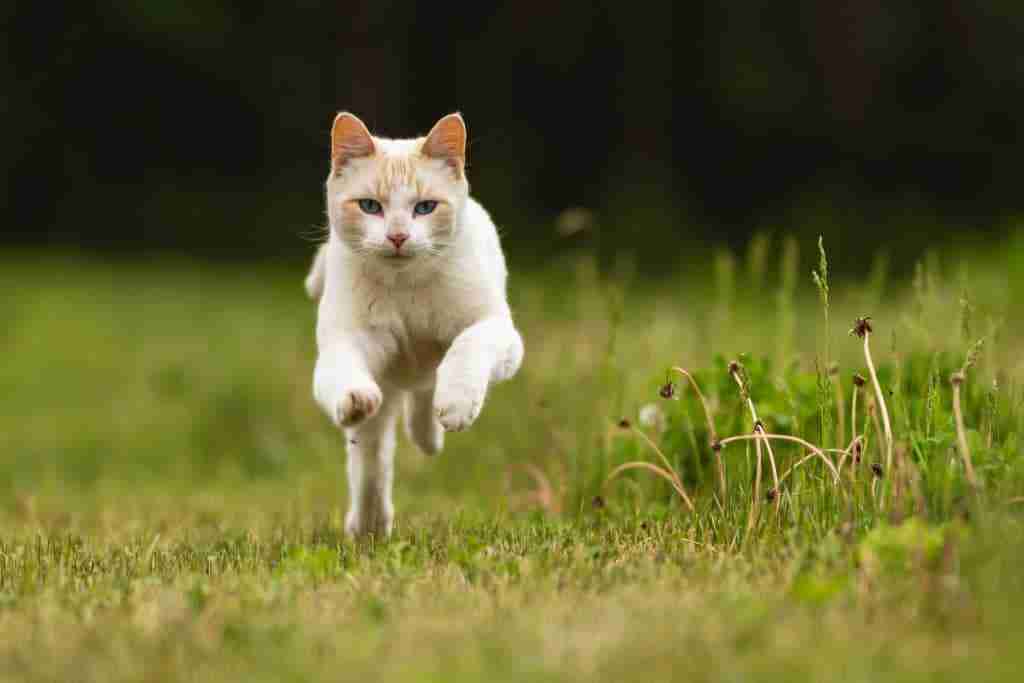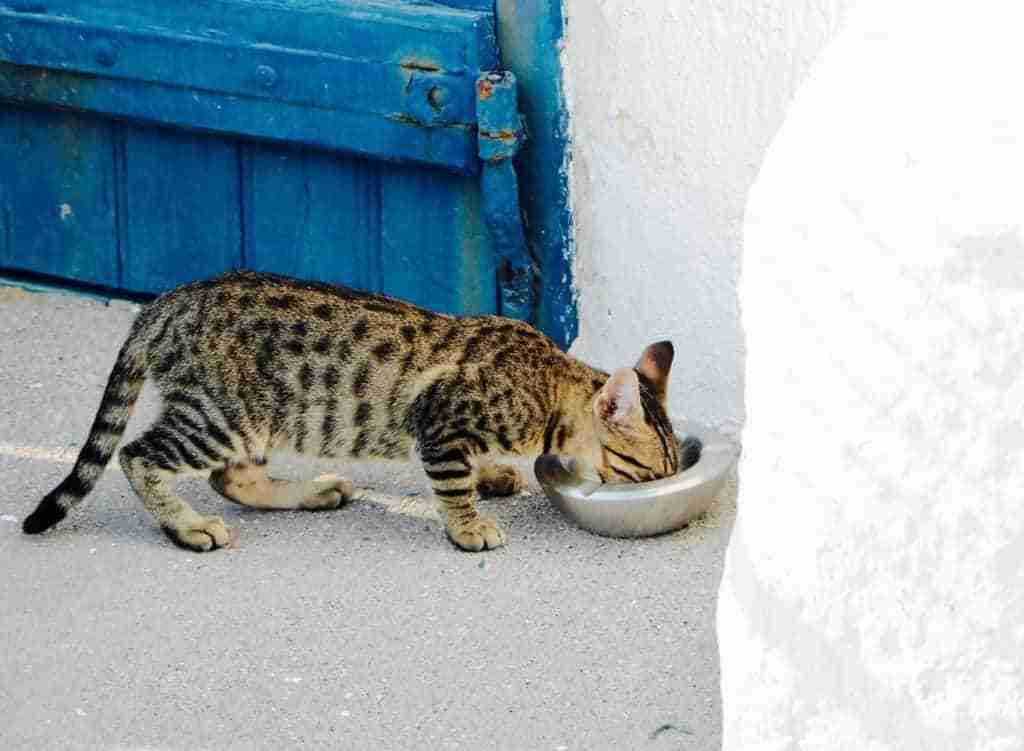Want the best cat food for weight loss? Our Top Pick is : Purina Pro Plan Focus Healthy Metabolism Formula Canned Cat Food
As responsible cat owners, we always like to take care of our cats. It is easy to worry about whether they have enough to eat, we can fix this problem simply and feel good about ourselves by putting out plenty of food for our pets. Often, it is not until the vet tells us our cat is overweight and needs to slim down, that we suddenly realize there is a problem and our kindness may actually be cruelty! Here I am going to look at how you can identify if your cat is overweight, what risks they may be under from excessive weight gain, how they might have gotten to this point, what we can do in terms of weight management to rectify the situation and get them back to an ideal weight. We will then identify the best cat foods for weight loss so you can easily rectify weight issues in overweight cats.
Is your cat too heavy?

When you see your cat each day it can be difficult to see tiny changes in their appearance. The length of the coat can easily hide subtle changes and you can often put down appearance changes to your cat transitioning through different stages of life.
Often one of the easiest ways to notice a change in your cat’s weight is to compare photos from a previous month to a recent photo to see clear “before and after” type shots. Personally I only noticed my cats change in weight when they jumped on me and I noticed the extra heavy landing!
Animal health care professionals don’t get to see your cat every day. And some cats are naturally more heavily framed and muscled than others. So how do such professionals identify a cat that is carrying too much body fat for their frame and is therefore overweight or too heavy?
The answer is that they look for pre-determined cues. If your cat is bony to touch, has no fat on its ribs and the stomach caves in behind the rib cage it is likely to be chronically underweight. If your cat has obvious fat deposits on the face, limbs, lumbar region, an extended belly and little evidence of a waistline they are clearly overweight. Ideally, your cat should have good proportions, a moderate waistline behind the rib cage and a thin coating of fat over the ribs and abdomen. You could have a 20lb cat that is underweight or a 10lb cat that is overweight but these cues can help you identify if your cat is too fat.
It is thought that 25% of cats in western societies are obese, and such obesity is very common in older and neutered cats so if you think your cat is looking normal it could be that they are obese and look like a lot of other cats out there! Go with the cues if in doubt…
Health Risks For Overweight Cats
Why should you care if your cat is overweight? Shows they are living a good life, yes? Well no…..unfortunately, like us humans, too much weight can lead to long term problems that can severely ruin the quality of life for kitty. Whilst things might seem trouble-free in the short term poor weight management can lead to :
Damaged joints – aka arthritis. Simply overloading the joints with a heavy body well beyond the design capability of the joints is going to lead painful, mobility decreasing, damage. Doesn’t matter if you are a cat or human – too much weight will put extra pressure on knees, hips, elbows, and feet. The longer you or your cat are overweight, the higher the odds that damage is taking place.
High blood pressure – extra body size puts extra pressure on the heart and reduces the body’s ability to transport blood through blood vessels. The end result might be a fatal heart attack if blood pressure is not brought under control – high blood pressure can also cause kidney damage and in cats, that can be fatal.
Diabetes – diabetes in cats is becoming more common. It is particularly prevalent in middle-aged to older cats, those that are overweight and often male cats in particular. Diabetes is a condition where the pancreas doesn’t create enough insulin to control blood sugar levels. This poor blood sugar control can lead to collapse and coma if left untreated. Early symptoms can be increased urination, poor coat condition, rapid weight loss, infections, and vomiting. You can help your cat avoid these outcomes if you prevent them from becoming overweight. Get more information on diabetes from the Blue Cross here.
Restricted breathing – You might notice your cat huffing and puffing and put it down to old age or lack of fitness from a sedentary lifestyle. Alternatively, you could have just let your cat get so overweight that they are suffering from a buildup of fat in the chest cavity. Not good. Your cat might find it hard to exercise the weight off if you have let things come to this. Clearly, if you can’t breathe you are in trouble…right?
Urinary tract infections – these are a pain, quite literally. Our tomcat demonstrated his trouble by taking a bloody pee in the bath. We simply wouldn’t have noticed if he hadn’t so eloquently demonstrated his problem. Obviously male cats have a rep for such infections but did you know obesity can bring on such infections (as well as diabetes!)? The upshot was, he required an expensive prescription diet for life and surgery to alter his plumbing. He wasn’t overweight, he was an outward bound muscle ball. Seriously, these infections are painful and often costly. Why take the risk?
Fatty Liver Disease – aka hepatic lipidosis. There is no real known cause of this liver problem, but obesity increases the odds of developing the problem. Essentially what seems to happen is the cat loses its appetite due to anxiety, change in circumstances or other environmental factors. The cat then starts to survive off its own fat stores. At some point the liver, which processes the fat, gets swamped and can’t handle the conversion and basically stops functioning leading to a health catastrophe. At this point things are bad, and if recovery is possible, it takes months and the cat needs feeding through IV in the meantime. If caught early your cat has an 80-90% chance of survival. If your late – 90% mortality rate…
And more – decreased immune function, constipation, and flatulence.
Obesity and being overweight is not a natural state conducive to survival. That’s why you should be alert to the weight of your cat and be careful to ensure they are at an ideal weight.
How Did Your Cat Get So Heavy?

Maybe you have decided your cat is a little overweight and you would like to avoid some of those nasty health outcomes? You might be wondering how did it come to this? Well it was easy, and it was probably just a little misjudgment, a little error on a daily basis, that added up to a growing problem when it compounded over time. The chances are one or all of these things happened :
Oversized portions
The most obvious cause was that you simply give your cat too much food to eat. Many cat owners “free feed” their cat – this is when you just put out food and trust the cat to moderate its diet. Your cat might not be the type that can free feed without putting on weight and hence they get big.
Sometimes this may be because they eat too quick for their brain to say “hey, we are full!” If you suspect free feeding and speed-eating could be the problem you could try a slow feed cat bowl. These give your cats appetite time to adjust as they eat so they stop eating without overdoing things!
You may not be free-feeding your cat, instead of relying on manufacturer labels that tell you how many tins or oz an “average” cat should eat. You then infer the correct amount to feed your cat – trouble is your cat might not be average and could be taking on additional calories without either of you realizing. The end result is insidious weight gain that is usually released months later and you have no idea how it happened!
Maybe you are a sucker for treating your cat. You wouldn’t be the first and won’t be the last – but like humans, too many treats can add up to a weight problem in the long run!
These are all straightforward ways your cat might be getting to large a portion and putting on weight.
Wrong Food Type
This problem is less common but could add up to an issue. You might be feeding your cat the wrong type of food. Many manufacturers make foods for kittens, young cats, adult cats, and seniors. Picking the wrong food may mean your cat is getting too much of a good thing!
Kitten food is high in calories to support a growing cat – if you are feeding this to a fully grown cat which may only be one year old then you could well be giving them to many calories….
Likewise, senior cats don’t often use as much energy as younger cats but need more vitamins and minerals to stay healthy and higher levels of protein as their gut efficiency decreases with age. If you go feeding a standard food they may well be getting too many calories and too little protein.
Multiple Feeding opportunities
If your cat is an outdoor cat, you might find the neighbors know your cat quite well. Could be your neighbors think your cat is actually their cat – kitty ends up with double portions…Maybe your cat regularly raids other cats’ food bowls as part of an ongoing turf war…perhaps your cat can’t pass the local bins without a bit of a dip?
Basically, if your cat goes outdoors it is very hard to control their diet. You may have been utterly responsible when it comes to their diet but who knows what double life they are leading in the big wild world?
Lack of exercise

Maybe your cat is a house cat and never venture outdoors. Maybe you only ever feed as recommended – no treats or free feeds. Why is your cat putting on weight? Lack of exercise – many indoor cats are sedentary and simply don’t burn the daily requirement off!
A lot of manufacturers recommend serving size based on a cat that lives indoors and outdoors. Indoor cats generally don’t walk many miles per day, leap over many fences or burn calories to keep warm – it is easy to see how an average recommendation might be wrong for your indoor cat.
Tips For Losing Weight
So, your cat is overweight, what can you do to get their weight under control? The first thing to note is that you must carry on feeding them. We have already seen how an obese cat that stops eating can develop fatty liver disease and we want to avoid this at all costs.
You probably suspect the reason your cat is overweight and know you need to cut down on treats or exercise a house cat more or even lock your cat indoors if you suspect the neighbors are feeding the cat… But, if you are really not sure what is causing their weight gain you are going to have to get control of all the variables.
To get immediate control you need to keep your cat indoors, carry out controlled feeding only, provide exercise indoors through play and start looking at the calories you are giving your cat. Which leads us to :
How much should I feed my cat to lose weight?
This is most likely to be the main reason your cat is overweight, you flat out don’t know how much to feed them! Don’t be too hard on yourself, it is an easy mistake to make and many owners make the same mistake.
What we particularly need to look at is their calorific requirements. Like us humans, cats gain or lose weight depending on whether they eat more calories than they burn or eat less than they burn. Now I am not going into a tutorial on calories and how they work here, suffice to say check out this feeding guide from the National Research Council for the low down on all things cat nutrition.
From the guide, we are particularly interested in how to identify an overweight cat, which we discussed earlier, and then you actually need to weigh your cat – because you might have a 10lb lean cat or a 10lb fat cat and they both need to eat different amounts in terms of calories.
Here is what the guide from the NRC says you should feed your cat in terms of calories per day to either maintain the weight and condition of a lean cat or to reduce the weight of an overweight cat until they are lean (once they are lean you increase the calories to those in the lean cat row to maintain condition without putting on weight) :
| Calories Per Day : | ||||
|---|---|---|---|---|
|
5lb |
10lb |
15lb |
20lb | |
|
Lean Cat |
170 |
280 |
360 |
440 |
|
Overweight Cat |
180 |
240 |
280 |
310 |
Armed with such information you can now study the food labels on cat food cans or packets and provide your overweight cat with the correct amounts of food to help them get down to a healthy, normal-weight which avoids the potential health problems brought about by being overweight.
Best Cat Food For Overweight Cats
If your cat is only slightly overweight you could use your normal, everyday cat food and just regulate the amount that your cat eats so it loses weight through calorie restriction.
If your cat is obese – rather overweight or most definitely rotund – then really you are best using a specialized weight loss cat food. This is because these specialized formulas ensure your cat gets enough protein and essential minerals and vitamins even though their calories are being restricted.
If you fed your obese cat a restricted-calorie diet based on the standard food formulas, over a longer period, you may inadvertently restrict protein and cause muscular waste rather than fat loss. Additionally, a diet higher in protein, fat, and fiber with reduced carbs tend to be more filling so your cat shouldn’t feel as hungry.
Whether your cat prefers dry food or wet food, is on a senior diet, specialist hairball or urinary diet you can usually find a weight loss cat food to suit.
our top picks of The Best cat food for Weight Loss :
- Iams Proactive Health Indoor Weight And Hairball
- Purina Pro Plan Focus Healthy Metabolism Formula
- Chicken Soup For The Soul Weight And Mature Care Canned Food For Senior Cats
- Blue Buffalo Wilderness Indoor Hairball And Weight Control
- Purina One Healthy Metabolism Adult Dry Cat Food
Best dry cat food for weight loss
We think Iams Proactive Health Indoor Weight And Hairball is the best overall choice if you are looking for dry cat food and your kitty needs to lose weight. The three main benefits of the Iams is that you don’t need a prescription, it is good value on volume and price and best of all, a high number of cat owners say their cats enjoy the flavor, few turn their noses up at it.

In terms of weight management, this food is high in protein (30%) and fiber(8.5%) meaning even though your cat might be on a calorie deficit they will feel full and will have enough protein to maintain their lean muscle mass while fat is lost.
They recommend that a cup measure contains 300 calories. You should be able to identify how many calories your cat needs from the chart above and measure out appropriately and spread over the course of a day.
Pros
- Good on price
- Easy to control calorie intake
- No perscription
- High protein, high fiber
- Good taste
- Easy to buy bulk
Negatives
- Limited choice of flavors
dry cat food that your cat will love and you can easily control portion size so they shed excess weight easily…
Best canned cat food for weight loss
We think the Purina Pro Plan Focus Healthy Metabolism Formula is the best choice of diet cat food for cats that have a preference for wet food. A wet food will be easier to eat if your cat has dental issues and will help keep your cat hydrated if you are not sure they are drinking enough water.

Each can is a 3oz serving with over 10% protein coming in at 83 calories per can. You might think, compared to dry food, that the protein intake is a little small but remember dry food figures are skewed by the lack of water included.
As with the Iams, you don’t need a prescription and this is often reflected in the price. At 83 calories per can, you should be able to feed your cat with good control over their calorie intake.
Few owners complain their cat won’t eat this food – the chicken in gravy option seems to be a tasty winner!
Pros
- Soft on the mouth
- Great for hydration and easy digestion
- Convenient size can at 3oz 86 calories
- Great taste
- High protein
- No prescription
- Price
Negatives
- Hard to store in bulk
- Heavy 24 can packs
- Limited choice of flavor options
At 86 calories per can and loved by cats this is a great wet food choice for the cat that needs to lose weight…
Best weight loss food for senior cats
We have picked Chicken Soup for the Soul weight and mature care canned food for senior cats ocean fish, chicken, and turkey. In truth, options for senior, obese cats seem to be limited probably because most senior cats have an issue with keeping weight on rather than losing it! However, Chicken Soup has had a go and to be fair the results are mixed – but in a small niche field they still come out top. The biggest problem is that cats love it and hate it in equal measure – if your cat loves it, your in!

The food is a US-made product and in fairness, they really have tried to up the quality stakes. The food is holistic using quality meat ingredients and short on grains. There are no artificial colors, flavors or preservatives and they have gone large on natural ingredients and balancing nutrients to make the healthiest food possible for your cat.
Cans are larger than normal at 5.5oz, with 146 calories per tin this means you might have partial cans open overnight depending on the deficit your cat needs to be on – they might have been better doing a 3 oz can for maintaining freshness and making it easier to hit the correct portion size.
The protein count comes in at 9% and obviously being soft is good for older teeth and poorer digestion that older cats might have. If your cat can get on with the flavor then you can feel good about the quality of food you are feeding them with this offering from chicken soup.
Pros
- No prescription
- High protein
- Easy to eat texture for older cats
- High-quality nutrition – no grains, additives
- Good for hydration
- Made in the US
- Value – 132oz per case
Negatives
- Less than appropriate can sizes
- Hit and miss appeal to cats
- Heavy 24 pack cases
Calorie controlled high quality nutrition for older cats. Easy eating texture and great for maintaining hydration…
Best grain-free cat food for weight loss
We have gone for dry food here – and we didn’t even consider it the best dry food for weight loss. It missed out on the basis that the price is a premium price compared to our choice, Iams.
We could have gone for wet, grain-free cat food but went with this because cats simply love it. If you have a picky eater, this is probably the grain-free choice you want and at 410 calories per cup and high protein (38%), it can be a good option for a controlled calorie weight loss plan.

We are talking about Blue Buffalo Wilderness indoor hairball and weight control. This food is made in the USA so it doesn’t have the production miles that might be negative for the planet. There is no corn, soy, wheat or gluten included so cats with allergies should not have a problem with this food. Hairball control is achieved through a unique fiber blend which helps maintain a healthy digestive system.
Blue Buffalo Weight Control is an all-round great choice for a cat who is a fussy eater, potentially suffers from allergies and who might be on the heavy side from a weight perspective.
Pros
- No grains
- High quality meat cuts used – 38% protein
- Tastes good
- No prescription
- Made in the US
- Controls hairball issues
Negatives
- Price
- Dry food option only
Top quality grain free high protein dry food loved by cats who need to shed weight…
Best Budget Cat food for weight loss
This was a tough pick. We could have gone for the Iams dry food based on price, popularity with cats and quality of ingredients or with the Purina wet food but ended up plumping for Purina One healthy metabolism adult dry cat food. The reason we went with the Purina offering was simply that the price was great, the protein levels are high in each cup serving (42%) and cats like the taste. The reason the Purina wasn’t the best dry food was that the calories per cup were a little high (427 calories) and it could be difficult to get the portion size right with such small measures involved.

Like other choices, we have made you don’t need a prescription.
Pros
- Price
- Flavorsome
- High Protein
- No prescription
Negatives
- Difficult to measure out – 427 cals/cup when your cat probably needs 250 cals/day
No nonsense, good value, high protein dry cat food that cats love and can help cut weight…
Our Top Pick
On balance we like the Purina Pro Plan Focus Healthy Metabolism Formula canned food best. We picked this because it had the best balance – price, taste, and ease of portion (calories) control. Additionally, you know your cat is going to be well hydrated and that digesting soft food should be less problematic. We think this food gives you a great chance of simply and efficiently controlling your cat’s weight by easily controlling their calorie intake. You don’t need a prescription and you should have a wide choice of outlets selling such a mainstream brand.
Don’t forget, whichever food you opt for don’t make any sudden changes – introduce your cat to new foods and brands slowly so their digestion can grow accustomed to the differences and you don’t end up sensitizing their stomachs and having to feed them sensitive stomach cat food…
